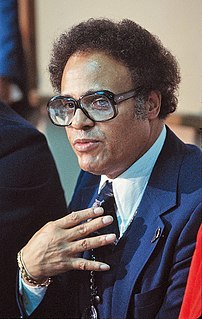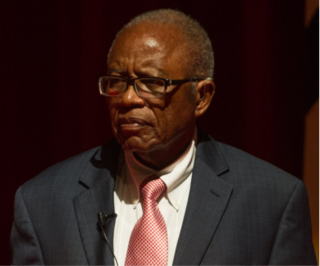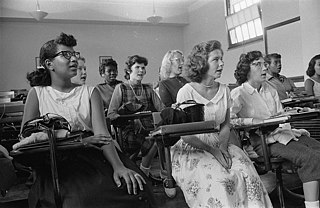
The American Civil Rights Movement was a political movement and campaign from 1954 to 1968 in the United States to abolish institutional racial segregation, discrimination, and disenfranchisement throughout the United States. The movement has its origins in the Reconstruction era during the late 19th century, although it made its largest legislative gains in the mid-1960s after years of direct actions and grassroots protests. The social movement's major nonviolent resistance and civil disobedience campaigns eventually secured new protections in federal law for the civil rights of all Americans.

Race-integration busing in the United States was the practice of assigning and transporting students to schools within or outside their local school districts in an effort to diversify the racial make-up of schools. While the 1954 U.S. Supreme Court landmark decision in Brown v. Board of Education declared racial segregation in public schools unconstitutional, many American schools continue to remain largely uni-racial due to housing inequality. In an effort to address the ongoing de facto segregation in schools, the 1971 Supreme Court decision, Swann v. Charlotte-Mecklenburg Board of Education, ruled that the federal courts could use busing as a further integration tool to achieve racial balance.

Daisy Bates was an American civil rights activist, publisher, journalist, and lecturer who played a leading role in the Little Rock Integration Crisis of 1957.

The NAACP Legal Defense and Educational Fund, Inc. is a leading United States civil rights organization and law firm based in New York City.

Benjamin Lawson Hooks was an American civil rights leader and government official. A Baptist minister and practicing attorney, he served as executive director of the National Association for the Advancement of Colored People (NAACP) from 1977 to 1992.
The civil rights movement (1896–1954) was a long, primarily nonviolent action to bring full civil rights and equality under the law to all Americans. The era has had a lasting impact on American society – in its tactics, the increased social and legal acceptance of civil rights, and in its exposure of the prevalence and cost of racism.

Vivian Juanita Malone Jones was one of the first two black students to enroll at the University of Alabama in 1963, and in 1965 became the university's first black graduate. She was made famous when George Wallace, the Governor of Alabama, attempted to block her and James Hood from enrolling at the all-white university.

Willye F. Clayton Dennis was an American librarian, civil rights activist and Florida state legislator. She was the first African-American Chief of Children's Services for the Jacksonville Public Library System. She was elected president of the Jacksonville branch of the National Association for the Advancement of Colored People, president of the Jacksonville Alumnae Chapter of Delta Sigma Theta and elected to the 15th District of the Florida House of Representatives for two terms.

Fred David Gray is a civil rights attorney, preacher and activist who practices law in Alabama. He litigated several major civil rights cases in Alabama, including some, such as Browder v. Gayle, that reached the United States Supreme Court for rulings. He served as the President of the National Bar Association in 1985, and in 2001 was elected as the first African-American President of the Alabama State Bar.

Alexander Pierre "A. P." Tureaud, Sr. was an African-American attorney who headed the legal team for the New Orleans chapter of the NAACP during the Civil Rights Movement. With the assistance of Thurgood Marshall and Robert Carter from the NAACP Legal Defense and Educational Fund, A. P. Tureaud filed the lawsuit that successfully ended the system of Jim Crow segregation in New Orleans. That case paved the way for integrating the first two elementary schools in the Deep South.

The National Association for the Advancement of Colored People (NAACP) is a civil rights organization in the United States, formed in 1909 as an interracial endeavor to advance justice for African Americans by a group including W. E. B. Du Bois, Mary White Ovington, Moorfield Storey and Ida B. Wells. Leaders of the organization include Thurgood Marshall and Roy Wilkins.
The Atlanta Student Movement was formed in February of 1960 in Atlanta by students of the campuses Atlanta University Center (AUC). It was led by the Committee on the Appeal for Human Rights (COAHR) and was part of the Civil Rights Movement.

School segregation in the United States (US) is the separation of students based on their race to the extent that an institution can be racially predominant by black students or white students. Currently more than half of all students in the United States attend school distracts with high racial concentration and about 40% of black students attend schools where 90%-100% of students are non-white. School racial segregation is worst in the northeastern U.S.

School integration in the United States is the process of ending race-based segregation within American public and private schools. Racial segregation in schools existed throughout most of American history and remains an issue in contemporary education. During the Civil Rights Movement school integration became a priority, but since then de facto segregation has again become prevalent.
This is a timeline of the 1947 to 1968 civil rights movement in the United States, a nonviolent mid-20th century freedom movement to gain legal equality and the enforcement of constitutional rights for People of Color. The goals of the movement included securing equal protection under the law, ending legally established racial discrimination, and gaining equal access to public facilities, education reform, fair housing, and the ability to vote.
The Arkansas State Press was an African-American newspaper published from 1941 to 1959. Dubbed "Little Rock's leading African-American newspaper," its owners and editors were Daisy Bates and L. C. Bates. According to historians, the newspaper was "believed by many to be instrumental in bringing about the desegregation of the Little Rock public schools."
East Side High School was a senior high school in Cleveland, Mississippi, within the Mississippi Delta region. It was a part of the Cleveland School District and the building itself remains such as a middle school. In September 2017, it was merged into Cleveland Central High School.
Murray Atkins Walls (1899–1993) was an American high school teacher and civil rights activist from Indianapolis who fought for the integration of Louisville public libraries after being denied access to research for a speaking engagement in Louisville, Kentucky.
Prior to the civil rights movement in South Carolina, African Americans in the state had very few political rights. South Carolina briefly had a majority-black government during the Reconstruction era after the Civil War, but with the 1876 inauguration of Governor Wade Hampton III, a Democrat who supported the disenfranchisement of blacks, African Americans in South Carolina struggled to exercise their rights. Poll taxes, literacy tests, and intimidation kept African Americans from voting, and it was virtually impossible for someone to challenge the Democratic Party, which ran unopposed in most state elections for decades. By 1940, the voter registration provisions written into the 1895 constitution effectively limited African-American voters to 3,000—only 0.8 percent of those of voting age in the state.
The Atlanta sit-ins were a series of sit-ins that took place in Atlanta, Georgia, United States. Occurring during the sit-in movement of the larger civil rights movement, the sit-ins were organized by the Committee on Appeal for Human Rights, which consisted of students from the Atlanta University Center. The sit-ins were inspired by the Greensboro sit-ins, which had started a month earlier in Greensboro, North Carolina with the goal of desegregating the lunch counters in the city. The Atlanta protests lasted for almost a year before an agreement was made to desegregate the lunch counters in the city.











